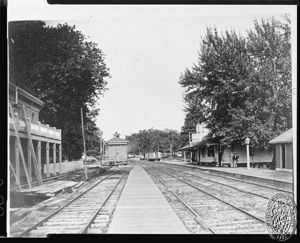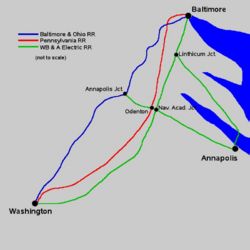Annapolis and Elk Ridge Railroad
| Annapolis and Elk Ridge Railroad | |
|---|---|
| System map 1890 map showing the A&ER, by then the A,W&B | |
| Locale | Annapolis Junction, Maryland, to Annapolis, Maryland |
| Dates of operation | 1837 – 1935 |
| Track gauge | 4 ft 8½ in (1435 mm) (standard gauge) |
| Headquarters | Annapolis, Maryland |
The Annapolis and Elk Ridge Railroad, later the Annapolis, Washington & Baltimore Railroad, once provided rail service to Annapolis, Maryland and was one of the earliest railroads in the U.S. It later merged into the Washington, Baltimore and Annapolis Railroad and was finally abandoned. The only traces of it today are a few small sidings and telephone poles that follow its former right of way.
Contents
History
Origins
In 1835, the Baltimore and Ohio Railroad opened its Washington branch, connecting the B&O main line just outside Baltimore to Washington, DC. In 1836, the Maryland General Assembly voted to sponsor construction of a rail line to service the state capital in Annapolis. On March 21 1837, a charter was granted to the Annapolis and Elk Ridge Railroad.[1] As originally planned, instead of proceeding directly to Washington or Balitmore, the line was to start at Elk Ridge Landing in the western part of modern day Anne Arundel County. There it could connect not only with the B&O Railroad but also with ships on the Patapsco River.[2] Instead, the line started at a point named Annapolis Junction near Savage Factory around milestone 18 on the Washington branch of the B&O Railroad.
Construction started on June 12, 1838[3], and on December 25 1840, and after $405,658.65 in construction, $300,000 of which came from the state[3], service was inaugurated out of the West Street station in Annapolis[2] with fares of $2 to Baltimore, $2.50 to Washington, D.C., and local stations at 6¼ cents per mile. The railroad was single-tracked along most of its length and followed the watershed (or crest) dividing drainage into the Severn River on the north and the Patuxent River basin to the south. There were trestles spanning Chandlers Run and Rouges Harbor Branch and an excavation at Magazine Hill just east of Waterbury.
Elk Ridge later shortened its name to Elkridge, and the railroad did likewise, becoming the Annapolis & Elkridge Railroad. Crownsville, Millersville, and later Odenton are other present-day towns that were served by the railroad.
Civil War Involvement
During the Civil War, the railroad had strategic significance and was the scene of a minor conflict early in the war. The Union's Massachusetts Infantry was moving south to secure Washington, D.C., but Maryland, a slave state, contained many southern sympathizers and when the troops attempted to march through the city the Baltimore riot of 1861 broke out. Troops were subsequently shipped to Annapolis, where they attempted to use the railroad to reach Washington via Annapolis Junction. But on April 21 1861, the telegraph lines and many sections of track had been torn up by Marylanders dissatisfied with the outcome of the riot. The tracks were soon repaired by troops under the command of General Benjamin Franklin Butler.[4]
Rail Expansion
The industrial era saw a major expansion of railroads into the area. The Pennsylvania Railroad-controlled Baltimore & Potomac Railroad was built in the 1870's to compete with the B&O. The town of Odenton (named for B&P president and Maryland governor Oden Bowie) grew up where this road crossed the Annapolis & Elkridge roughly five miles east of Annapolis Junction.
Bankruptcy
In October 1879 the Maryland Board of Public Works began to investigate why, in 40 years, the railroad had not paid any of the interest on the state's $300,000 investment. The A&ER management blamed competition from ferry boats and high interchange tariffs charge by the Baltimore and Ohio.[3]
In 1884 the railroad's private stockholders sued to force the sale of the railroad to recover part of their investment. The state attempted to prevent the sale, but in July 1885 the injunction they had obtained was dissolved and on November 10 of that year the Annapolis and Elkridge Railroad was sold for $100,000.[3]
Reorganization
The railroad was reorganized on March 24, 1886 and rechartered as the Annapolis, Washington & Baltimore Railroad (AW&B) with power granted to expand to multiple locations throughout the state.[5]
Connection Lines and Competition
While the A&ER reorganized, a new railroad, the Annapolis and Bay Ridge Railroad began operation on July 10, 1886. It connected to the AW&B at Bay Ridge Junction and connected Annapolis with the resort town of Bay Ridge, Maryland. In September of that year it was bought out by the B&O railroad.[3]
Competition came in the form of the Annapolis & Baltimore Short Line Railroad, later the Baltimore & Annapolis Short Line Railroad, which opened in 1887. It also served Annapolis, but provided a faster connection to Baltimore, taking a more direct path along the north shore of the Severn River. It also connected to the AW&B at Bay Ridge Junction.
Purchase and Merger
In 1902, the Washington, Baltimore, and Annapolis Electric Railway began constructing a third rail line between Baltimore and Washington, DC. This line crossed the AW&B just east of Odenton at a place called Naval Academy Junction. The WB&A was an electric interurban streetcar line, a new and exciting mode of transportation at the turn of the 20th century.
In 1903, the AW&B was purchased by the WB&A and reopened in 1908 as an electric interurban line.[2]. The two lines crossed just east of Odenton at a point called Naval Academy Junction. In 1921, the WB&A also acquired the Baltimore & Annapolis Short Line, after which the AW&B trackage was termed the South Shore Division and the Short Line the North Shore Division.
World War I
In 1917, as the U.S. entered World War I the railroad interests in the area persuaded the U.S. Army to acquire land and open a training facility in the area roughly bounded by the B&O Washington Branch on the west, the Pennsylvania Railroad on the east, and the South Shore line of the WB&A to the south. The installation was named Camp Meade and was supposed to be a temporary facility, used only for the duration of the war (it is still in use today). The WB&A saw record traffic during this time as a result of freight and passenger service to the camp. In 1918, the railroad system carried 5,946,697 paying passengers.
End of the Line
In 1931, during the Great Depression, the WB&A went into receivership. The rise of the automobile marked the end of the WB&A, along with most other electric interurbans. The system remained in operation for four more years until operation officially ceased on August 20 1935. The WB&A was sold at public auction with scrap dealers buying most of the rolling stock. In 1935 the vast majority of the South Shore division was abandoned and sold for scrap. The portion between Annapolis Junction and Odenton was purchased and operated by the B&O to serve Fort Meade until, sometime before 1981, it too was removed. This left only the junction tracks at Annapolis Junction--now part of an aggregates terminal.
Stations on the Line
- Annapolis Junction - connection with the B&O
- Camp Meade Junction
- Portland
- Disney (Disney Rd)
- Admiral
- Fairall
- Odenton - connection with the Pennsylvania RR (B&P)
- Naval Academy Junction - connection with the WB&A
- Sappington (Sappington Station Rd)
- Gambrills
- Holladay
- Millersville
- Arundel
- Waterbury (Waterbury Rd)
- Gott
- Crownsville
- Belvoir (Belvoir Manor)
- Arth
- Iglehart (Sherwood Forest)
- Woytych
- Hockley
- Best Gate
- Camp Parole
- Homewood
- Cedar Park
- Bay Ridge Junction - connection with the A&BR
- Annapolis (West Street)
- Annapolis (U.S. Naval Academy)
Surviving Landmarks
- The wye of track where the Annapolis & Elkridge joined the B&O Washington Branch (now CSX) in Annapolis Junction is still intact. It now serves a cement plant.
- A short siding in Odenton that follows the original roadbed just east of the Pennsylvania Railroad (now Amtrak). It serves a defunct factory and is set to be abandoned.
- Bridge over Dorsey Run
- Plans exist to build a bike trail, called the South Shore Trail, on 10 miles of the right-of-way between Odenton and Bestgate Road in Annapolis
- Generals Highway was built on the right of way.
- Poplar Avenue in Annapolis was built next to the right of way.
References
- ↑ Annapolis & E.R.R. Company v. Anne Arundel County Com'r, 103 U.S. 1 (1880) (October 1880). Retrieved on 2006-10-03.
- ↑ 2.0 2.1 2.2 Herbert H. Harwood Jr. (2004-2005). Annapolis & Elk Ridge Railroad. Retrieved on 2006-10-12.
- ↑ 3.0 3.1 3.2 3.3 3.4 Annapolis Railroads (January 17, 2001). Retrieved on 2006-11-17.
- ↑ Loudon Park National Cemetery Description. Retrieved on 2006-10-13.
- ↑ Session Laws of Maryland, 1886 (1886). Retrieved on 2006-11-10.
- Merriken, John E. (1993). Every Hour On The Hour; A Chronicle of the Washington, Baltimore & Annapolis Electric Railroad. Taylor Publishing Company. ISBN 0-9600938-3-4.
External links
- Baltimore & Ohio Railroad Museum
- Modern-day photo tour of the Annapolis & Elk Ridge Railroad Right of Way
| List of United States railroads by political division | |
|---|---|
| Alabama · Alaska · Arizona · Arkansas · California · Colorado · Connecticut · Delaware · Florida · Georgia · Hawaii · Idaho · Illinois · Indiana · Iowa · Kansas · Kentucky · Louisiana · Maine · Maryland · Massachusetts · Michigan · Minnesota · Mississippi · Missouri · Montana · Nebraska · Nevada · New Hampshire · New Jersey · New Mexico · New York · North Carolina · North Dakota · Ohio · Oklahoma · Oregon · Pennsylvania · Rhode Island · South Carolina · South Dakota · Tennessee · Texas · Utah · Vermont · Virginia · Washington · West Virginia · Wisconsin · Wyoming | |
| District of Columbia · Puerto Rico | |
|
| |
| See also: List of defunct United States railroads | |


